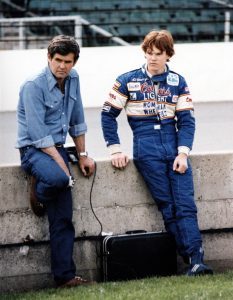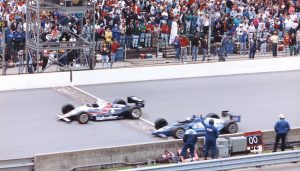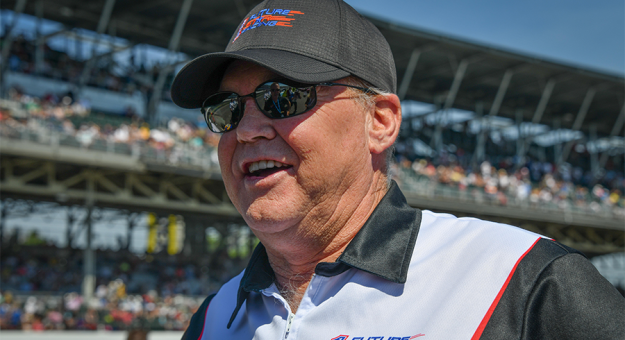The Unser name rings loud around the 2.5-mile oval of Indianapolis Motor Speedway every year when the NTT IndyCar Series hits the race track during the month of May, and for good reason.
Two generations of the Unser family have won multiple Indianapolis 500s, including Al Unser’s monumental four victories in the Greatest Spectacle in Racing, tied for the most all-time with A.J. Foyt, Rick Mears and Helio Castroneves.
Alongside Unser was his brother Bobby Unser, who planted his face on the Borg-Warner trophy three times after winning in 1968, 1975 and 1981.
Then came along Al Unser’s son Al Unser Jr. Known as “Little Al” by many, Unser was naturally destined to be an open-wheel racer. With the Unser name already iconic at the speedway, Unser Jr. was devoted to finding success in the event.
“Well, there is a bit of pressure. It came from me, it was my own pressure that I put on myself,” Unser told SPEED SPORT. “It didn’t come from Uncle Bobby (Unser) or my dad (Al Unser) or anything like that.

“I wanted to be successful at Indy, and the only way you can do that is by winning the race. That’s being successful at Indy. It took me a long time. It was my 10th start that I won the 500. I honestly was hoping that it would happen sooner than that, but it didn’t.”
Unser came close to dousing himself in milk in 1989. Battling Emerson Fittipaldi with two laps to go, neither driver gave an inch. Coming up on lapped traffic, the two leaders touched wheels while battling, sending Unser into the wall in the short chute between turns three and four. Fittipaldi won the race.
“Honestly, it’s devastating to come that close and not win,” Unser said. “Back at that time it was a month’s worth of work, and practicing, qualifying and all that kind of stuff. You spent a lot of time there.
“To be that close, it’s hard to describe, it’s hard to put into words when you don’t succeed, and you just come that close.”
Though Unser took the loss with class, not pinning the blame on anyone that day.
Unser’s day in the 500-mile race would soon come.
The First Breakthrough
Three years later, heartbreak turned into triumph for Unser, who edged Scott Goodyear by a mere .043 seconds, the closest finish in Indy 500 history.

Looking back on the breakthrough, the most vivid memory Unser has is quite simple.
“Staying in front of Scott Goodyear,” Unser said with a laugh. “That was the biggest thing. Really, that day, the whole race, Michael Andretti was in a world of his own. He had everybody covered. I think at one point, he had the entire field a lap down.”
Andretti looked to be in command of the event, gapping second-place by nearly 30 seconds before a fuel pump failure on his race car ended the second-generation racer’s chances with 11 laps to go.
“Then it became a race between Scott and I,” Unser said. “Which we had already been racing like that for the last 50 laps, but it was for second. So no one was really seeing it until Michael broke.
“Then it was for the win. Once that happened, it was all about just keeping Scott behind me.”
Unser held off Goodyear around the final 10 circuits to cement his name in motorsports history aboard Rick Galles’ Kraco Racing No. 3 Valvoline Chevrolet.
Taming “The Beast”
Unser’s second and final Indy triumph came with Team Penske in 1994. Though this time under vastly different circumstances. He and teammate, Fittipaldi, dominated the month of May with Penske’s innovative, but highly secretive, 209-cubic-inch, pushrod Mercedes engine.
Late in the race, Fittipaldi crashed out of the lead while attempting to lap Unser, who was running second at the time. From there, Unser skated away to victory, with only runner-up Jacques Villeneuve finishing on the same lap.
Penske’s project was so powerful, only one other driver (Jacques Villeneuve, second) was on the lead lap at the drop of the checkered flag.
“It was just a monumental effort. It was just a great effort,” Unser recalled. “We didn’t know really if the engine was gonna make it or not.
“We had only completed 500 miles one time prior to the Indy 500. Just the development of that pushrod engine was a phenomenal effort. I was super lucky to be a part of Penske Racing at that time.”
The Magnitude Of Indy
Now nearly three decades since his last triumph at Indy, Unser still looks forward to the event and the unique pageantry it holds.
“The Indy 500 is an event. Yes, it’s a race, but it’s more than just a race,” Unser said. “The competitors, we have to treat it as just another race because the fundamentals are the same. As I walk around there today, it’s hard to win the Indy 500 no matter what.
“No matter if you have a dominant engine like we did in 1994, or how close it is today, it’s hard to win that race. The strategies have changed because of the formula of cars they’re running today.
“But it’s just as hard to win it today, as it was in 1911 with Ray Harroun. You got to prepare the best you can and then hope that everything goes your way on race day.”
Follow @DHoffmanMedia22